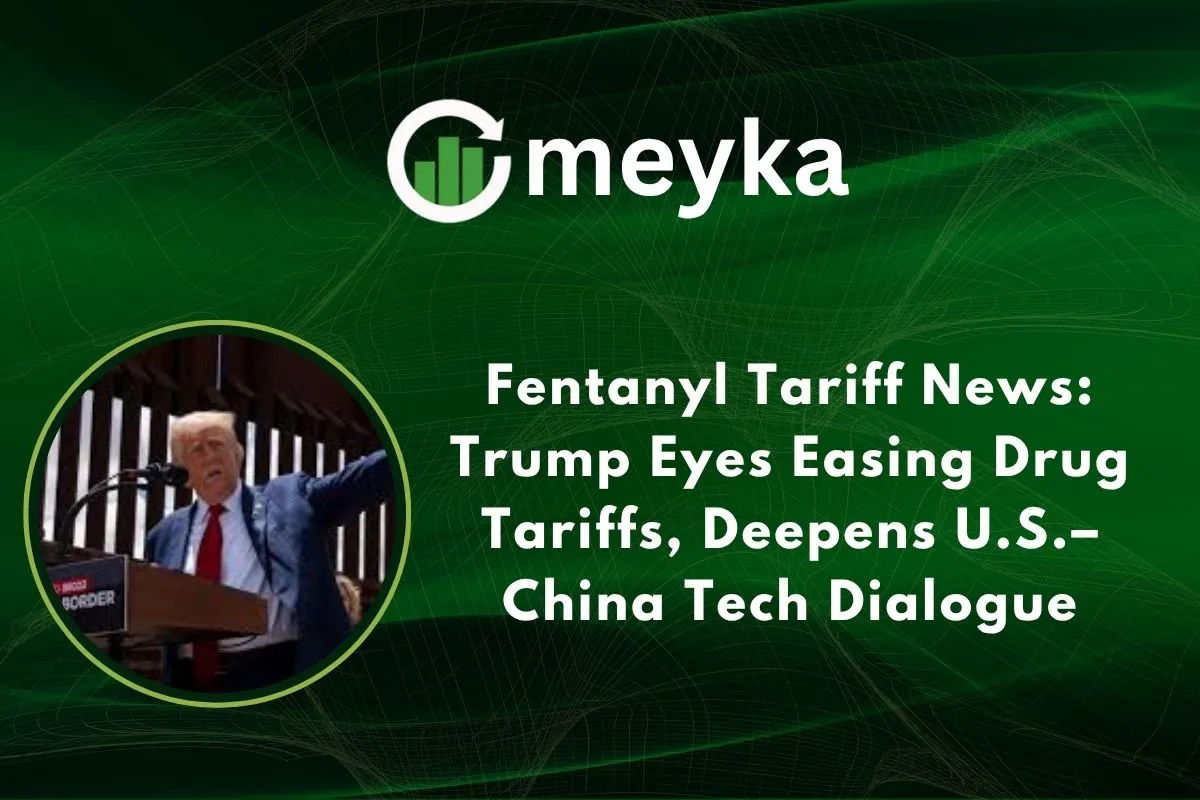Fentanyl Tariff News: Trump Eyes Easing Drug Tariffs, Deepens U.S.–China Tech Dialogue
The term “fentanyl tariff” has entered political-economic discourse as Donald Trump’s administration signals a move to reduce U.S. tariffs on Chinese goods tied to the fight against synthetic opioid imports. According to multiple sources, the U.S. is preparing to lower a roughly 20 % levy on Chinese goods originally imposed over alleged Chinese shipments of fentanyl precursors. This shift comes at the same time as Trump and China’s Xi Jinping plan to deepen dialogue on technology, semiconductors and supply-chain issues. For investors and market watchers, the confluence of drug-policy, trade-tariffs and tech diplomacy makes the “fentanyl tariff” issue a meaningful theme, both for risk and for opportunity.
The “Fentanyl Tariff” Mechanism: Scope and Rationale
What the levy covers
Early in 2025, the U.S. invoked the International Emergency Economic Powers Act (IEEPA) to impose tariffs on imports from China tied to synthetic‐opioid flows. By February, the U.S. added a roughly 10 % tariff on Chinese goods citing “the flow of fentanyl into our country.” On March 4, that figure rose to 20% as part of a broader trade escalation.
Why the measure matters
This tariff is unique: it links drug enforcement (specifically the flow of fentanyl and its precursor chemicals) with trade policy. The U.S. argues China remains a key source of fentanyl precursors and thus uses the tariff as leverage.
Investor significance
For global supply-chains, a 20 % tariff on Chinese goods increases input costs across manufacturing, importers and retail. A reduction or removal signals relief for firms relying on Chinese components, especially in technology, industrial and consumer sectors. At the same time, the trade-drug nexus introduces policy risk: a bounce in Chinese exports if concessions are made, or renewed tariffs if not. For investors this means: watch earnings of import-heavy U.S. firms, monitor Chinese export volumes, and treat the tariff as both a policy lever and a trade-shock variable.
U.S.–China Tech Dialogue & Tariff Linkage
The diplomatic pivot
Trump and Xi are scheduled to meet shortly, with a framework that ties tariff relief to Chinese action on fentanyl precursors and, concurrently, technology issues such as chip exports, AI platforms and supply-chain access.
Technologies at stake
Facilities like NVIDIA Corporation (NVDA) were mentioned explicitly in the context of the talks, Trump said he’d raise the company’s flagship Blackwell AI chip in discussions. The tech linkage means that tariff relief may come with conditions on Chinese access to U.S. or allied semiconductor ecosystems.
Investor Takeaway: Technology and manufacturing firms with China exposure stand to benefit if tariffs ease. For example, U.S. chip makers, equipment suppliers and contract manufacturers may see demand rebound. But any conditionality, such as export curbs, licensing delays or restricted access, could dampen upside. Investors should track upcoming meeting outcomes, public statements, and subsequent regulatory announcements. A tariff-cut announcement tied to tech cooperation could trigger a rally in semiconductor stocks; a tech-friction outcome could offset tariff relief gains.
Market Sentiment & Investor Reaction
Immediate reactions
On October 29, 2025, Trump publicly announced he expects to lower the 20 % fentanyl-related tariff on Chinese goods. Markets responded: for example, certain semiconductor stocks with China exposure saw intraday gains following the announcement.
Social media & sentiment
The Chinese foreign ministry posted on X (formerly Twitter), criticizing the linkage and calling the tariff pressure “blackmail”. That signal underscores the potential for diplomatic negative surprises.
What this means for investors
Sentiment is currently tilted positive, expectation of tariff relief plus tech dialogue gives hope. For investors:
- Monitor announcement timing and terms: an outlined reduction (for example, “cut by up to 10 percentage points”) could trigger markets.
- Confirm that relief is sustained rather than symbolic: if Chinese action on fentanyl precursors is mandated, delays or non-compliance could spook markets.
- Stay aware of collateral risk: if China retaliates on unrelated tariffs or restricts tech access, relief in one area may be offset.
Policy and Economic Implications
Trade-cost impact
Reducing a 20 % tariff on Chinese goods would lower direct cost burdens on U.S. importers. That may ease inflationary pressure on consumer goods, particularly electronics, appliances, and manufacturing inputs.
Drug-policy intersection
By tying tariffs to fentanyl precursor exports, the U.S. is leveraging trade policy for security objectives. The precedent may widen the scope of trade instruments used for non-traditional aims. For firms with global supply chains, this raises policy‐compliance risk.
Long-term structural risks
If tariff relief leads to tech-and-trade cooperation, China’s semiconductor ecosystem might accelerate, reducing U.S. dominance and reshaping comparative advantage. Investors should consider:
- Will U.S. firms gain access to Chinese markets or component supply chains?
- Will Chinese manufacturers gain more freedom to export tech without U.S. restraints?
- Does tariff relief pave the way for broader normalization, or is it a tactical truce?
Conclusion
The “fentanyl tariff” is not just a headline grabber; it intersects trade, drug-policy, and technology in a high-stakes U.S.–China framework. From an investment perspective, its reduction signals potential cost relief for import-heavy firms and an improved outlook for technology and manufacturing sectors. But it also comes with conditionality: Chinese action on fentanyl precursors, and deeper tech-access negotiations. Looking ahead, investors should track the upcoming Trump–Xi meeting outcomes, official tariff-reduction announcements, and any signals of tech-supply-chain liberalisation. Acting now means positioning for upside, while hedging for policy‐reversal risk. For example, importers and electronics firms may see margin expansion; tech equipment makers may gain new access, but geopolitical or policy mis-steps could reverse sentiment quickly.
In short: this is a turning point where trade policy, public-health objectives and technology strategy converge, and investors who stay alert could gain.
FAQS
The fentanyl tariff refers to the additional U.S. duty (roughly 20 % on Chinese goods) imposed under the International Emergency Economic Powers Act, to pressure China to curb exports of fentanyl precursor chemicals.
On October 29, 2025, President Trump announced he expects to lower the tariff, as part of a deal in talks with China’s President Xi Jinping that links tariff relief to Chinese cooperation on both drug precursor controls and technology exports.
Import-reliant manufacturing, consumer electronics, semiconductor equipment and contract manufacturers with China exposure would benefit from cost relief and improved supply-chain signals.
Disclaimer:
The content shared by Meyka AI PTY LTD is solely for research and informational purposes. Meyka is not a financial advisory service, and the information provided should not be considered investment or trading advice.






